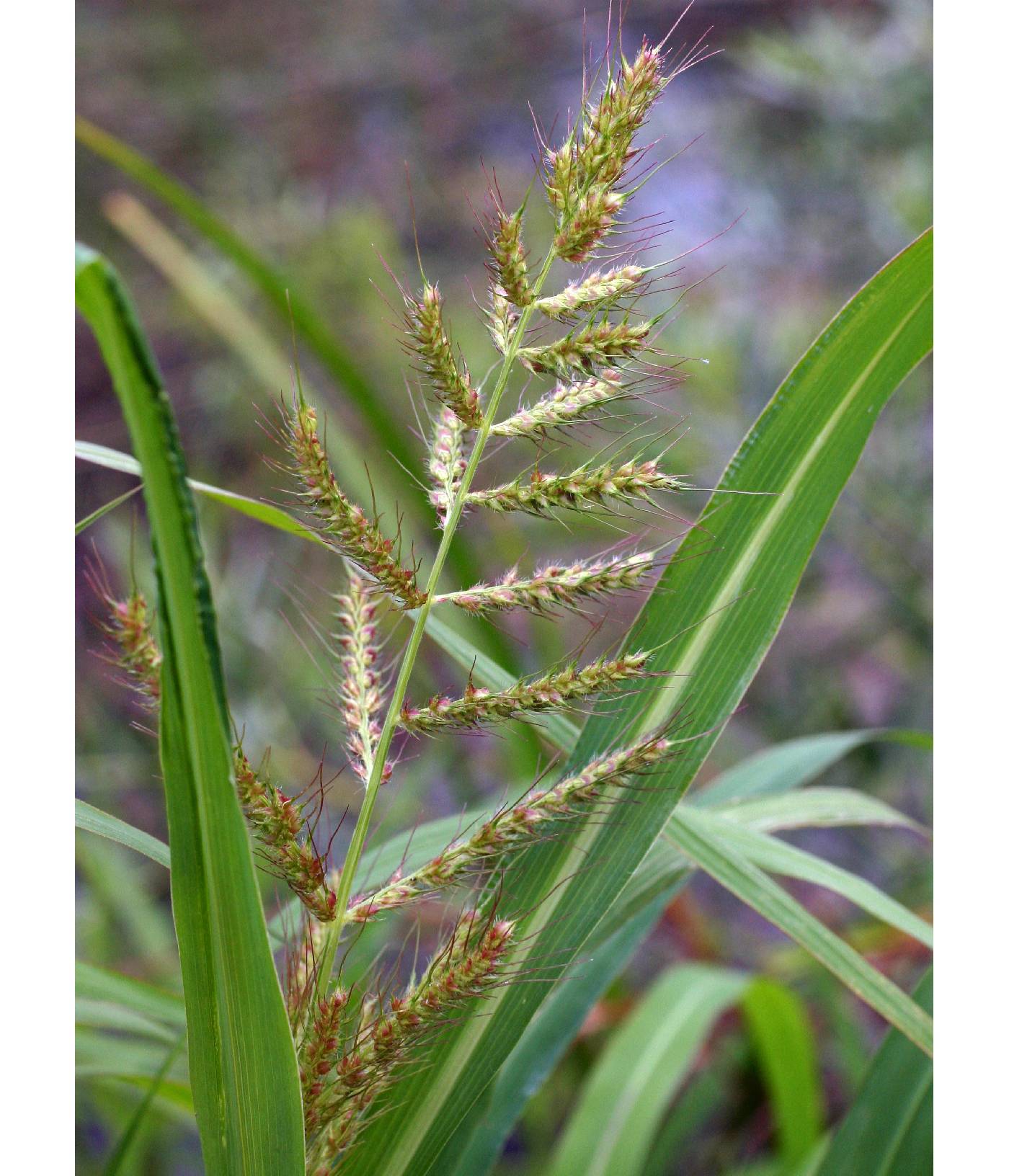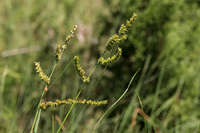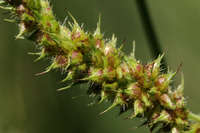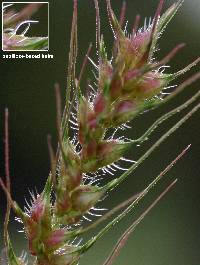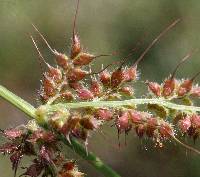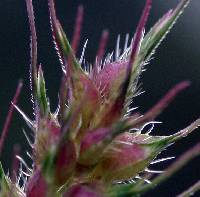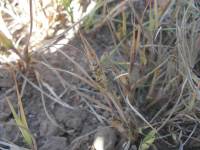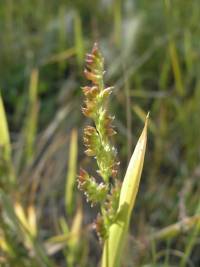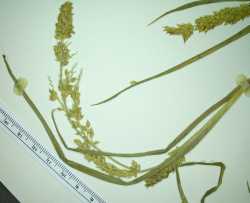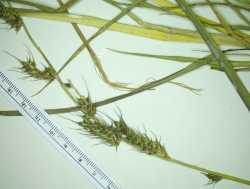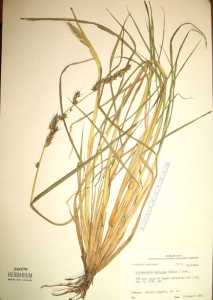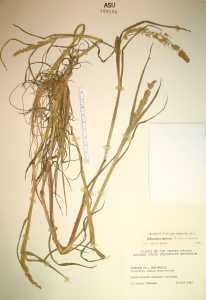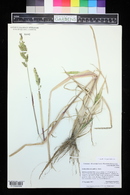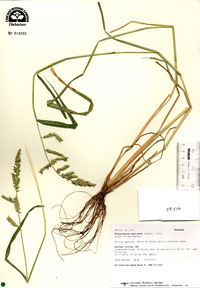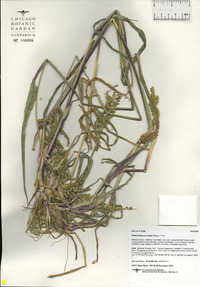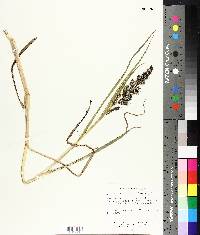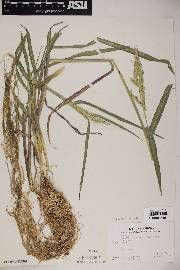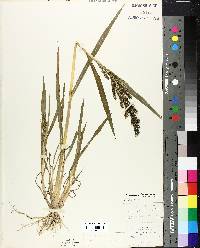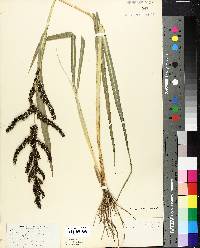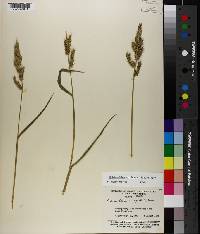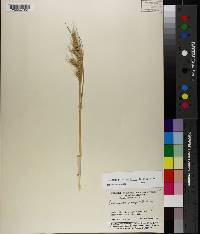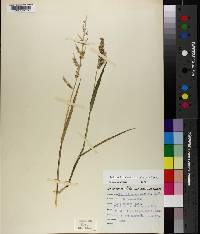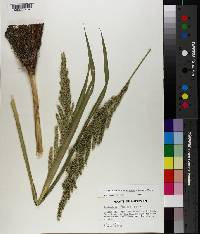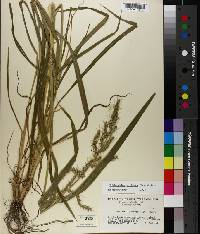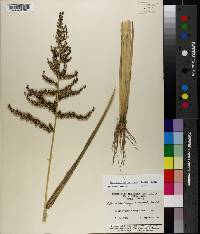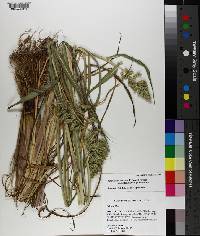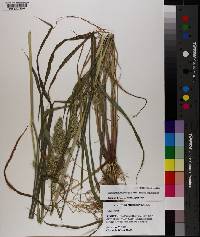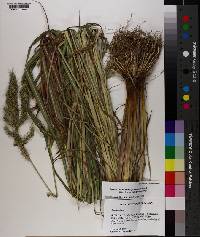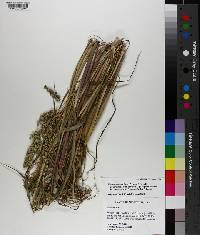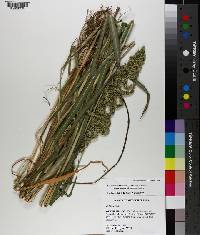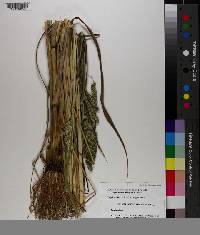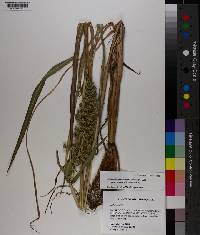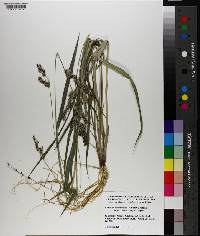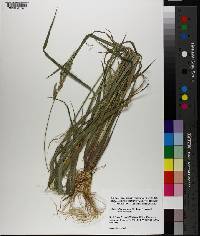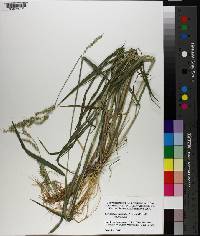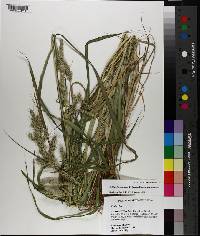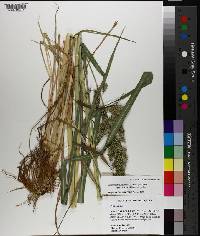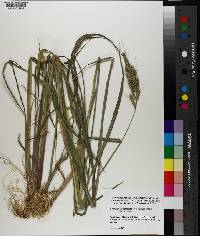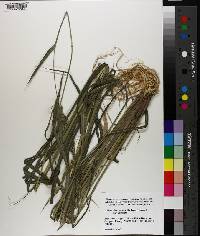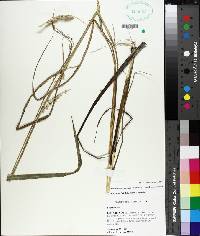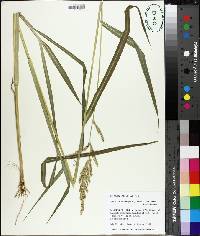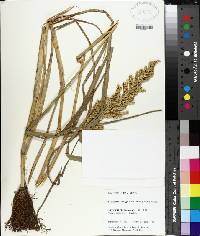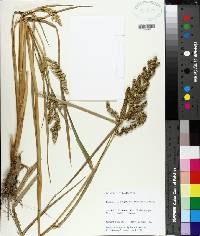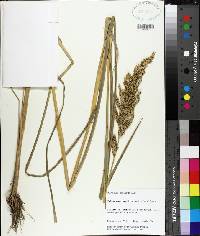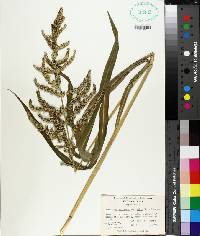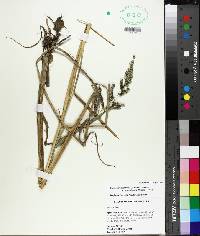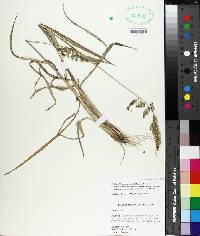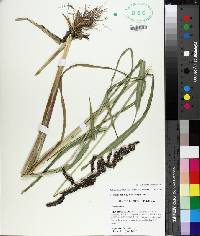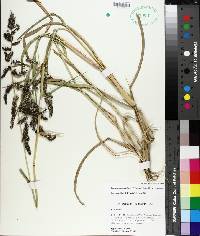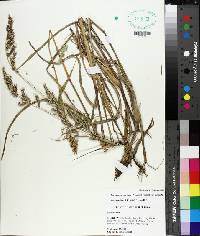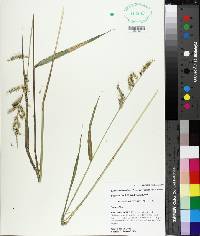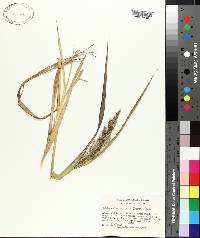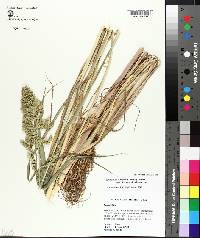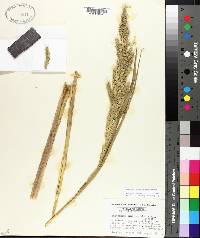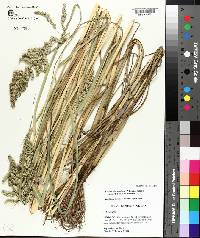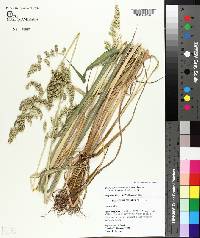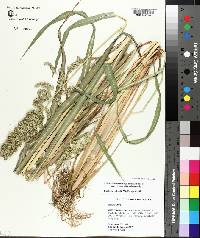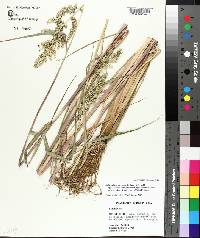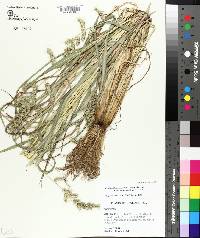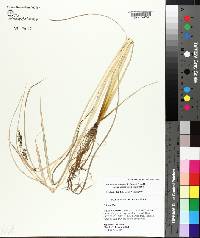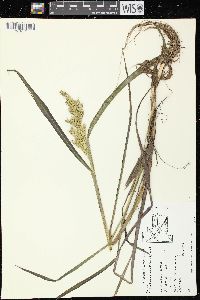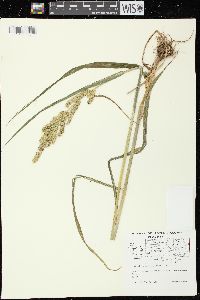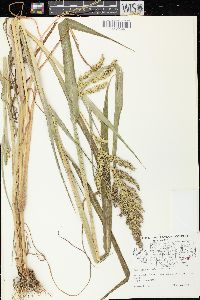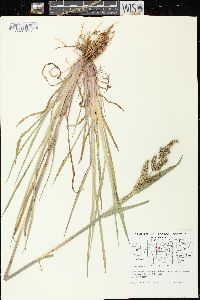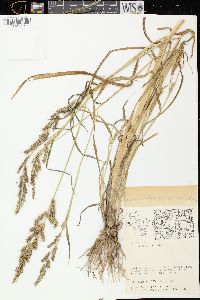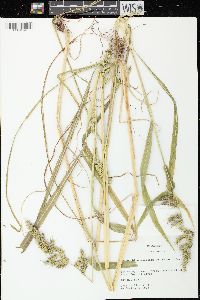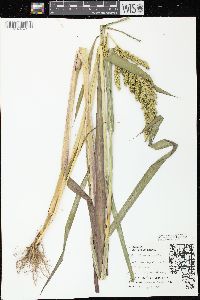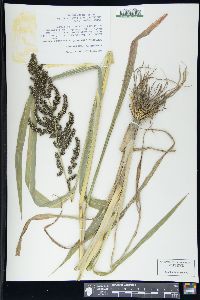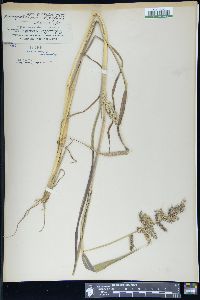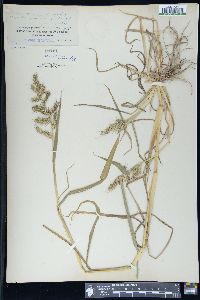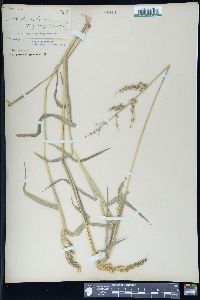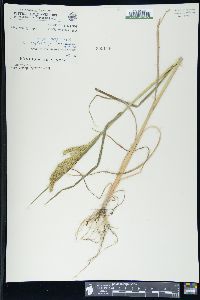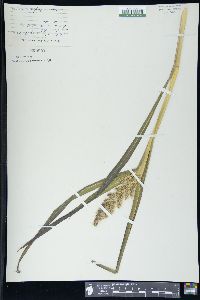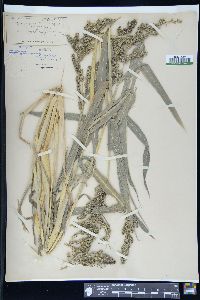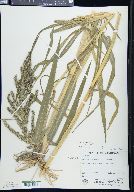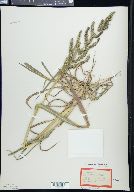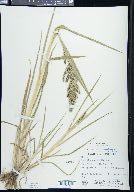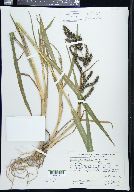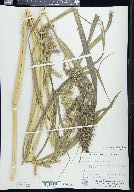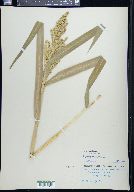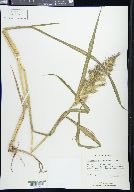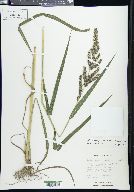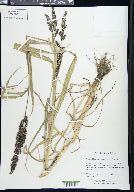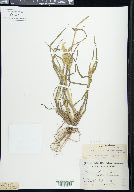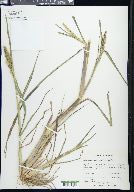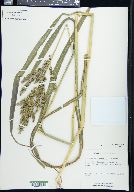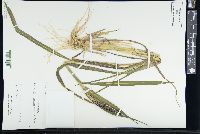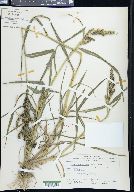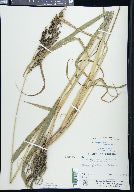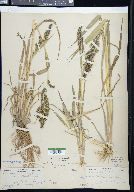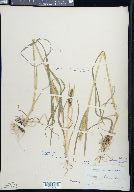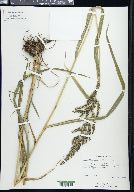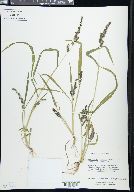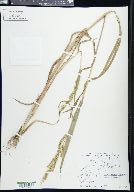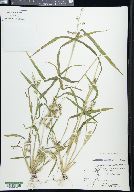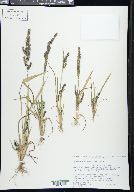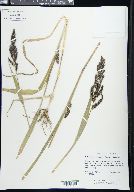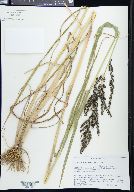
|
|
|
|
Family: Poaceae
Rough Barnyard Grass, more...American Barnyard Grass, rough barnyardgrass
[Echinochloa crus-galli var. microstachya, moreEchinochloa pungens var. wiegandii] |
Plants annual. Culms 80-160 cm, erect or spreading, sometimes rooting at the lowest nodes, often developing short axillary flowering shoots at most upper nodes when mature; lower nodes glabrous or puberulent; upper nodes glabrous. Sheaths glabrous; ligules absent; blades 1-27 cm long, 0.8-30 mm wide. Panicles of primary culms 7-35 cm, rachises and branches glabrous or hispid, hairs to 3 mm, papillose-based; primary branches 2-8 cm, usually spreading and rather distant, often with secondary branches. Spikelets 2.5-5 mm, disarticulating at maturity, usually purple or streaked with purple, usually hispid, hairs papillose-based. Upper glumes about as long as the spikelets; lower florets sterile; lower lemmas unawned or awned, awns to 16 mm; lower paleas well-developed; upper lemmas broadly obovoid or orbicular, narrowing to an acute or acuminate coriaceous portion that extends into the membranous tip, boundary between the coriaceous and membranous portions not marked by minute hairs; anthers 0.4-1.1 mm. Caryopses 1.2-2.5 mm, broadly obovoid or spheroid, yellowish; embryos 1.4-2 mm, 80-91% as long as the caryopses. 2n = 36. Echinochloa muricata is native to North America, growing from southern Canada to northern Mexico in moist, often disturbed sites (but not rice fields). It resembles E. crus-galli in gross morphology and ecology, but differs consistently by the characters used in the key. The two varieties tend to be distinct, but there is some overlap in both morphology and geography. Annual herb 0.8 - 1.5 m tall Leaves: alternate, two-ranked. Sheaths open, compressed. Ligules absent. Blades 1 - 27 cm long, 0.5 mm - 3 cm wide, usually over ten times longer than wide, linear to lance-shaped, flat, parallel-veined, with a prominent midrib. Inflorescence: a terminal arrangement of spikelets (panicle), to 35 cm long, with an elongate and sometimes hairy axis. Primary branches spreading, distant, 2 - 8 cm long, often bearing secondary branches. Fruit: a caryopsis, indehiscent, enclosed within the persistent lemma and palea, yellowish, 1 - 2.5 mm long, broadly egg-shaped to spherical. Culm: upright or spreading, 0.8 - 1.5 m long, round in cross-section, sometimes rooting at the lower nodes, often developing short axillary shoots at the upper nodes when mature. Lower nodes sometimes minutely hairy. Spikelets: densely crowded on angular branches, purple or purple-streaked, 2.5 - 5 mm long, flat on one side and convex on the other (plano-convex), with bumpy-based hairs. Florets: two per spikelet. Lower florets sterile. Upper florets bisexual, compressed dorsally. Anthers three, 0.5 - 1 mm long. Stigmas red. Glumes:: Lower glumes membranous. Upper glumes about equal to spikelets, membranous. Lemmas:: Lower lemmas similar to upper glumes in texture and size, sometimes bristle-tipped (bristle to 1.5 cm long). Upper lemmas broadly reverse egg-shaped or circular with a leather-like, narrowing apex (tip membranous), rounded dorsally, leather-like. Paleas:: Lower paleas well-developed. Similar species: No information at this time. Flowering: August to October Habitat and ecology: Disturbed areas, often in moist soil. Occurence in the Chicago region: native Etymology: Echinochloa comes from the Greek words echinos, meaning hedgehog, and chloa, meaning grass, referring to the bristly spikelets of some species. Muricata means roughened. Author: The Morton Arboretum Erect or decumbent, branched from the base, often 1 m or more; sheaths glabrous; blades 8-30 mm wide; infl 1-3 dm, erect, typically with spreading, somewhat distant branches 2-8 cm, the longer ones rebranched, the main axis and branches glabrous or variously hairy but without conspicuous long setae, the hairs rarely over 3 mm; spikelets commonly purplish; second glume and sterile lemma about equal, usually beset with stout, papillose- based hairs at least on the veins, the glume awnless or nearly so; fertile lemma ca twice as long as wide, abruptly narrowed to an acuminate, persistent tip not sharply differentiated from the body; 2n=36. Damp or muddy ground, or a weed in waste places; Me. and Que. to Alta. and Wash., s. to Fla., Tex., Calif., and n. Mex. Two vars., both widespread in our range. Gleason, Henry A. & Cronquist, Arthur J. 1991. Manual of vascular plants of northeastern United States and adjacent Canada. lxxv + 910 pp. ©The New York Botanical Garden. All rights reserved. Used by permission. From Flora of Indiana (1940) by Charles C. Deam Indiana Coefficient of Conservatism: C = 1 Wetland Indicator Status: OBL Deam (1940) did not recognize this species and instead considered it a part of a polymorphic Echinochloa crus-galli. Deam (1929): In ponds and sloughs where germination may be delayed on account of the recession fo the water, I have seen mature plants only a few inches high in fruit while on the higher margin of the same pond would be plants several feet high. |
|
|
|

